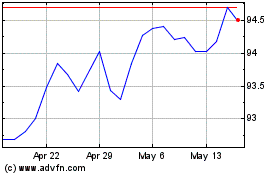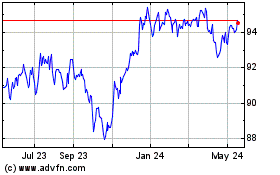Is the Party Over for Junk Bonds? - Analyst Blog
January 21 2013 - 9:20AM
Zacks
High-risk high-yield bonds a.k.a.
speculative bonds or junk bonds are those rated below BBB- by
Standard & Poor’s rating agency. The default rate for junk
bonds has been low at about 3.2% recently versus the historical
norm of 4.5%. The outlook for the default rate is favorable in the
near term.
Junk bonds have boomed following
the Fed’s decision to continue with its loose monetary policy with
$85 billion in monthly asset purchases. In fact, quantitative
easing, accompanied by rock-bottom interest rates, has been accused
of creating asset bubbles in places such as the treasury bond and
the junk bond markets.
With investors chasing higher yield
in the wake of low returns on other assets, high yield issuers
raised a record quantum of debt in 2012. Fund raising companies
have frequently used the proceeds to refinance higher
interest-bearing loans. Some of the money ended up with private
equity firms, such as Bain Capital, who borrow for leveraged
buyouts and then burden the company with debt. In any case, there
is no doubt that the boom in junk bonds has ensured access to
capital markets for even those companies with the lowest credit
ratings.
The chase for yield has driven down
the yield on junk bonds to record lows. In fact, the interest in
such bonds has been so great that some mutual funds have even
refused to take new investors. Junk bond yields recently fell below
6% for the first time (giving them about 500 basis points spread
over U.S. Treasury bills). From a historical perspective, junk bond
issuers have paid about 10% in interest charges. (It is noteworthy
that while yields may currently be low, spreads are nowhere near
their historical bottom.)
After several years of tidy
returns, returns from junk bonds came to over 15% in 2012. The
sharpest appreciation has been in the lowly CCC rated paper. With
good returns in the period following the financial crisis in 2008,
market mavens wonder if there is much room left for capital
appreciation or whether these bonds are to be held as a coupon play
only.
Risks to the high yield market
include a cyclical rotation into equities, firmer interest rates or
a weaker economy, which would increase corporate default. Even
without any recession, there is risk in the sense that should
earnings take off again, then investors may bail out of debt to
enter the stock market. Furthermore, investors face potential
losses in case of callable bonds.
T. Rowe Price High Yield Fund gave
an annual return of 15.2% in 2012 and a 3-year return of
10.8%. Prominent leveraged plays in this fund include
Sprint Nextel Corp. (S) and CIT Group
Inc. (CIT).
The Putnam High Yield Advantage
Fund gave an annual return of 15.1% in 2012 and a 3-year return of
10.4%. Noteworthy leveraged plays in this fund include HCA
Holdings, Inc. (HCA) and SLM Corporation
(SLM).
Besides high yield mutual funds,
investors may also select from the following two high yield bond
ETFs, both of which are well tracked, offer high liquidity and may
be considered to be a proxy for the junk bond market. The
iShares iBoxx $ High Yield Corporate Bd (HYG) and
SPDR Barclays High Yield Bond (JNK) are well known
junk bond ETFs.
CIT GROUP (CIT): Free Stock Analysis Report
HCA HOLDINGS (HCA): Free Stock Analysis Report
ISHARS-IBX HYCB (HYG): ETF Research Reports
SPDR-BC HY BD (JNK): ETF Research Reports
SPRINT NEXTEL (S): Free Stock Analysis Report
SLM CORP (SLM): Free Stock Analysis Report
To read this article on Zacks.com click here.
Zacks Investment Research
SPDR Bloomberg High Yiel... (AMEX:JNK)
Historical Stock Chart
From Sep 2024 to Oct 2024

SPDR Bloomberg High Yiel... (AMEX:JNK)
Historical Stock Chart
From Oct 2023 to Oct 2024
